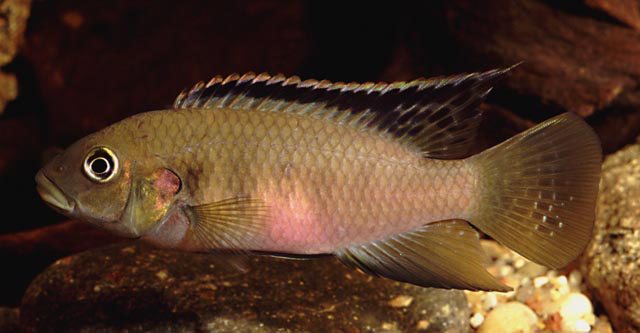| Cichlidae (Cichlids), subfamily: Pseudocrenilabrinae |
| 7.8 cm SL (male/unsexed) |
|
benthopelagic; pH range: 6 - 7; dH range: 3 - 10; depth range - 0 m, non-migratory |
| Africa: coastal regions of western Cameroon around Moliwe and Douala, and on Fernando Poo (=Bioko) (Equatorial Guinea) (Ref. 81260). |
|
Dorsal spines (total): 15-16; Dorsal soft rays (total): 9-10; Anal spines: 3-3; Anal soft rays: 8-8. Diagnosis: dense black band of coloration in dorsal fin membrane (Ref. 81260).
Description: body depth 34.9-37.6% SL; head length 33.6-37.9% SL; caudal peduncle deeper than long; some dorsal and anal fin rays elongated; caudal rounded in both sexes (Ref. 81260).
Coloration: body brown, paler ventrally; stressed individuals often with 2 horizontal stripes on flanks; occasionally 4-5 large, bar-like blotches are visible on the body, but these never extend over entire flank; dorsal fin and upper part of caudal with red margin; females with chrome-colored region on soft dorsal, sometimes upper third of caudal also chrome-colored; broad, black submarginal band in dorsal fin; in females black band runs most of fin length, in males it is restricted to a zone between spinous and soft rays; males sometimes with some rows of small maculae on caudal fin; juveniles and sometimes adults with a distinct "tilapia spot" on soft dorsal, but in most adults this is obscured by the broad black submarginal band; cheek and opercle with bluish to green iridescent flush; lower lips whitish gray; belly of ripe females with rosy coloration (Ref. 81260). |
| In coastal rivers and creeks (Ref. 42576). Pair-bonding, ovophilic mouthbrooder with delayed uptake; spawns on open substrates and both parents brood offspring (Ref. 81260). |
|
Endangered (B1ab(iii)+2ab(iii))
(Ref. 96402)
|
| harmless |
|
Source and more info: www.fishbase.org. For personal, classroom, and other internal use only. Not for publication.
Page created by Jen, 05.08.02,
php script by kbanasihan 06/09/2010 ,
last modified by
dsantos, 20/08/10

